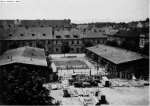 |
| Terezin |
The "Ghetto Theresienstadt" was established in NW Czechoslavakia. Terezin (Theresienstadt) was founded as a garrison
town in the late 18th Century, during the reign of Emperor
Joseph II and named after
his mother, Empress
Maria Theresa.
In WW2 the town served as a ghetto to which the Nazis expelled 140,000 Jews, mostly from the "Protectorate of Bohemia
and Moravia", but also from central and western Europe. The ghetto was controlled by the
Zentralamt für
die Regelung der Judenfrage in Böhmen und Mähren, which was under the jurisdiction of the RSHA.
The commandants were:
Siegfried Seidl,
November 1941 - July 1943;
Anton Burger,
July 1943 - February 1944,
and
Karl Rahm,
February 1944 - May 1945.
 |
| Gate #2 |
 |
| Gate #1 * |
All of the above were selected from
Adolf Eichmann's staff, and as well
as SS men; Czech gendarmes served as ghetto guards. The small fortress near the ghetto was used as
an internment camp for political prisoners.
Terezin was first mentioned in a Nazi document on
10 October 1941. The plan was to
concentrate there most of the Jews from the "Protectorate", Germany and other western
European countries, particularly prominent persons, old people, or those who had served
in the German Army during WW 1. The Jews should be transferred from Terezin gradually
to the death camps of
Aktion Reinhard and
Auschwitz.
Terezin also served to camouflage the extermination of the Jews from world opinion, by presenting it as a model
Jewish settlement.
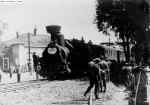 |
| Arrival at Bohusovice Station |
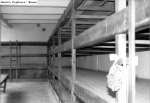 |
| Bunks |
The first group of Jews from
Praha arrived at the
end of November 1941. By
end of May 1942, 28,887 Jews
were deported to the ghetto, which was approximately one third of the Jewish
population in the "Protectorate". The first deportation from Terezin was 2,000 Jews to
Riga in
1942, where they
were massacred in the
Rumbuli forest.
In the
summer of 1942 thousands of Jews from Germany and Austria arrived, some were highly
decorated WW 1 soldiers. There was a permanent population of 30,000 - 40,000 in the Terezin Ghetto,
compared to a pre-war population of approximately 7,000. This gives some idea of the extent of overcrowding.
The peak population was 58,497 on
18 December 1942, living in an area of 125,770
square yards.
Internal affairs were run by a Council of Elders - heading the council was
Jacob Edelstein, succeeded by
Paul Epstein and Rabbi
Benjamin Murmelstein
of
Vienna. Rabbi
Leo Baeck was also
imprisoned in Terezin. The Jewish leaders had the terrible task of making up deportation lists,
allocating work in the ghetto, distribution of food, providing housing, overseeing sanitation,
and education. There was an intense cultural programme of activities, there were a large number
of writers, artists, several orchestras, an opera, theatre troupe, and 60,000 volume library,
specialising on Jewish subjects. The ghetto also had its own
currency.
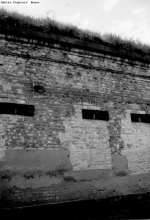 |
| Prison Cells |
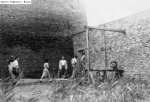 |
| Gallows |
In
September 1942, 18,639 Jews arrived in Terezin. 13,004 persons were
deported to the extermination
camps in the east, 3,941 died in the ghetto. The five transports to
Treblinka left Terezin
between 5 and 25
October 1942.
Richard Glazar, famous author of the book
"Trap with a Green Fence", was deported to
Treblinka on
Transport BU, his
registration number was BU639. This transport arrived in
Treblinka on
10 October 1942, at almost four o’clock in the afternoon.
Between 11 March 1942 and 13 June 1942, 13,001 Jews from Terezin were deported to the
Lublin District and the
Warsaw Ghetto (to
Warsaw only one transport - 1,000 people).
Between 19 September and 22 October 1942, 17,004 Jews were deported from Terezin
directly to
Treblinka. 30,005 Terezin Jews were victims of
Aktion Reinhard.
Deportations to Terezin came to a halt in the
first half of 1943, by which
time 90% of the Jews from the "Protectorate" and nearly all the Jews left in the
Reich had been brought to
the ghetto, also Jews
from the Netherlands and Denmark were transferred there. Deportations to
Auschwitz continued from time to time, until the
fall of 1944, then only 11,068 people remained in the ghetto.
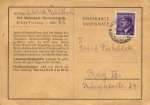 |
| Postcard |
In
1942 epidemics killed almost half the population, 15,891, by the
end of 1943, the ghetto health department had set up a network of
hospitals with 2,163 beds.
At the
end of 1943, the Nazis allowed an International Red Cross investigation
committee to visit Terezin in
1944, in order to show the world that the Nazis
did no harm to the Jews. In preparation for this visit the Nazis deported more prisoners to
Auschwitz so as to reduce the population. A number of changes were made,
such as dummy stores, a café, kindergardens, a school and flower gardens.
The Red Cross visited Terezin on
23 July 1944 and the Nazis made a propaganda
film, "The
Führer gives the Jews a town". After filming most of the cast, all the members of the
internal leadership, and nearly all the children were deported to
Auschwitz.
During the last six months of the camp's existence, some Jews were transferred to neutral countries,
1,200 Jews to Switzerland, Danish Jews to Sweden.
At the
end of April 1945, thousands of Jews were brought from other camps,
resulting in new outbreaks of epidemics. On
3 May 1945, five days before the
ghetto was liberated by the Red Army, the Nazis handed over Terezin to the Red Cross. A gas chamber was installed
in
1945, in a corridor of the fortifications wall near the former Litomerice gate,
but not put in action.
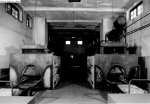 |
| Crematorium |
Between November 1941 and April 1945, 140,000 Jews were deported to Terezin.
Of these, 33,000 died there, 88,000 were deported to the extermination camps. At the time of liberation
19,000 were still alive, or had been transferred to neutral countries. Only 3,000 of those Jews deported to
the extermination camps survived (mainly
Auschwitz).
The 140,000 people deported to Terezin by country, were as follows:
Czechoslovakia - 75,500
Germany - 42,000
Austria - 15,000
Holland - 5,000
Hungary - 1,150
Poland - 1,000
Denmark - 500
Seidl and
Rahm were sentenced
to death and hanged by a Czech court.
Anton Burger escaped and was
sentenced to death in absentia.
The Central Database of Shoah Victims' Names
(Yad Vashem)
Photos: GFH
Terezin Memorial Museum (Donation of former prisoner Dr. Burian)
*
Sources:
Encyclopedia of the Holocaust
Richard Glazar: "Trap with a Green Fence"
Thanks to
Struan Robertson for
corrections.
© ARC 2005


















